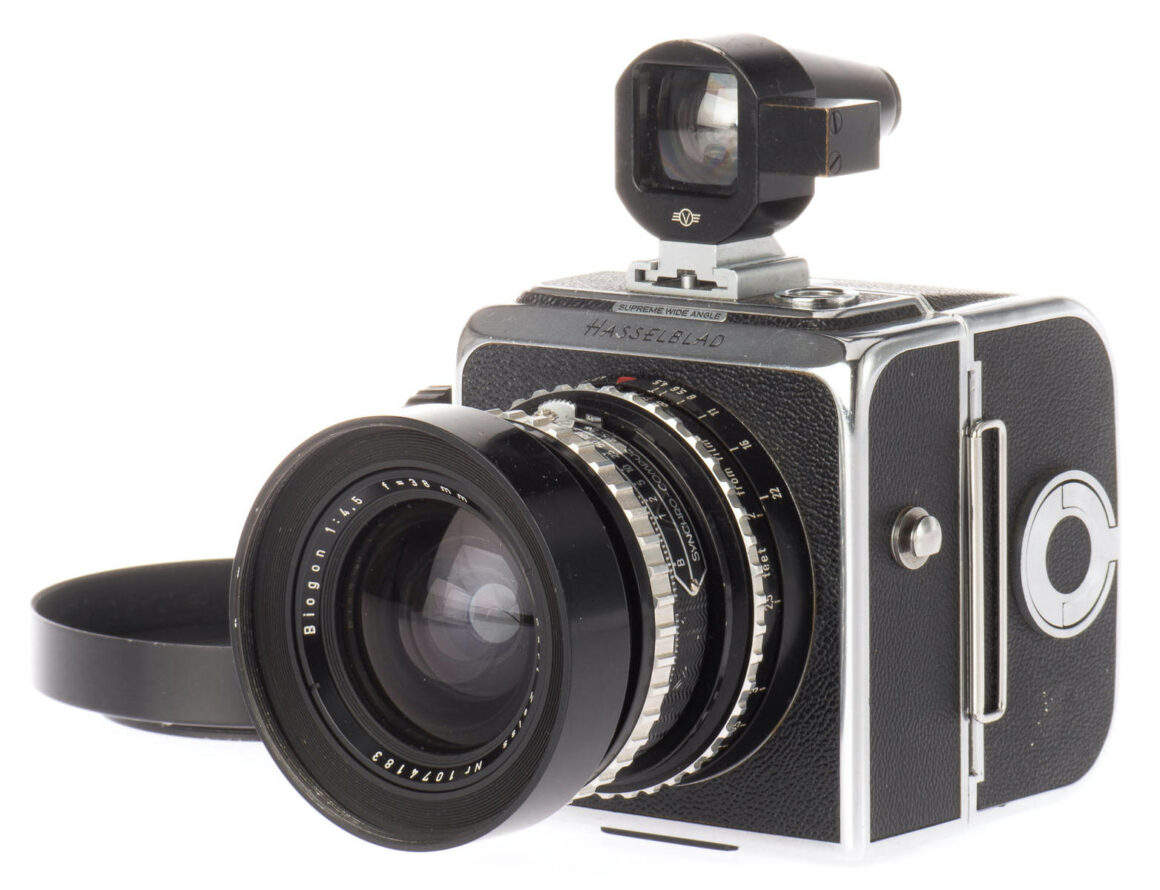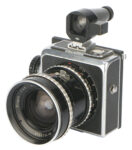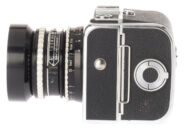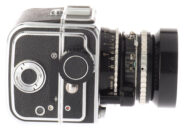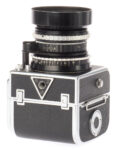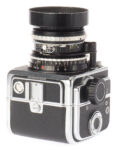Hasselblad SWA (SW) with Carl Zeiss Biogon 38mm F/4.5
Medium format MF film viewfinder camera
Specification
| Production details: | |
| Announced: | 1954 |
| System: | ● Hasselblad 1600F/1000F (1948) |
| Format: | |
| Maximum format: | Medium format 6x6 |
| Film type: | 120 roll film |
| Fixed lens: | |
| Original name: | Carl Zeiss Biogon 1:4.5 f=38mm |
| Focal length: | 38mm |
| Speed: | F/4.5 |
| Diagonal angle of view: | 92° |
| Lens construction: | 9 elements - 6 groups |
| Diaphragm type: | Preset |
| Closest focusing distance: | 0.5m |
| Manual focus control: | Focusing ring |
| Leaf shutter type and speeds: | Mechanical Synchro-Compur, 1 - 1/500 + B |
| Shutter: | |
| Type: | In-lens leaf shutter |
| Exposure: | |
| Exposure metering: | None |
| Exposure modes: | Manual |
| Physical characteristics: | |
| Weight: | <No data> |
| Dimensions: | <No data> |
Manufacturer description
The Hasselblad SW has many of the refinements which made the Hasselblad 1600 F and the Hasselblad 1000 F famous, like the interchangeable roll film magazines. That's because they're all parts of the same camera system. However, the SW differs in design on many essential points, since it is made to perform specialized tasks.
The Hasselblad SW is a 6X6 (2 1/4" X 2 1/4") camera and has a Synchro-Compur shutter with 10 speeds: B, 1, 1/2, 1/5, 1/10, 1/25, 1/50, 1/100, 1/250 and 1/500. It is completely synchronized for the use of flash bulbs and strobe speedlights. It has a self-timer. The scales are extra-easy to read. The controls are well placed and easy to get at.
The housing boasts some typical Hasselblad refinements, such as the interchangeable roll film magazines which enable you to change over instantly from black and white to color film, from one emulsion to another, and from an exposed roll to an unused one. The film indicator on the back tells you what kind of film you've loaded into the magazine you're using.
And, of course, the camera gives you niceties like a safe-guard against double exposure, a film advance signal, exposed film signal, exposure counter, etc.
***
The view-finder with level control is a typical Hasselblad refinement which permits you to make wide-angle pictures with no other help than your own hands.
A wide-angle camera, as you probably know, is particularly sensitive to deviations from the vertical film plane. In focusing on an object like the facade of a building, for instance, you must always make sure that the film plane is vertical - otherwise you get an abnormal perspective. Thanks to the level control - which is a built-in spirit level which can be viewed through a prisma at the same distance as the object you see in the view-finder - you can dispense with a tripod and the need for checking with your ground-glass screen.
You can be dead certain that even your snapshots will give you accurate perspectives. The view-finder is adequately corrected, gives a brilliant image, and is easy to fit and remove.
***
The Hasselblad SW uses a Zeiss Biogon 38mm (1 1/2 in.) f/4.5 lens, which gives you all of the following:
Picture angle: 90°.
Aperture: f/4.5.
Absolutely uniform illumination of entire image even at full opening.
Exceptionally good correction of all distortion.
The picture angle, 90°, is greater than any other medium-size camera with fixed lens has offered yet. The focal distance is only half as long as the diagonal of the negative.
Because of its fast lens, f/4.5, Hasselblad SW is superior to all other wide-angle cameras for medium and larger size negatives.
Despite its high speed the lens is a model of uniform illumination - no more vignetting even at full opening. The special design of the lens actually serves to enlarge the opening - the greater the entering light angle, the greater the compensation. This makes up in part for normal transmission losses.
The lens is exceptionally well corrected for all kinds of distortion - monochromatic and chromatic. This is of particularly great importance in reproducing details for architectural and technical purposes. Despite the large picture angle, the Biogon lens gives as flawless reproduction as can be obtained in photography.
Here's something else worth pointing out: the extreme depth of focus. At f/22 complete sharpness is obtained from 0.65 meter (25 1/2 in.) to infinity. Shortest focusing range: 1/2 meter (19 1/2 in.).
From the editor
The camera was announced at the Photokina 1954, Cologne, as "Supreme Wide Angle" (SWA). Stripped of the mirror mechanism and reflex focusing system, the camera body was essentially a flat box with a fixed lens (on one side) and a mount for interchangeable roll film magazines (on the other side), plus a removable optical direct vision view-finder.
A modified version, the Super Wide (SW), was released in 1955(*). In this version, the construction of the lens barrel was slightly changed.
(*) However, we have a Hasselblad brochure/instruction manual dated September 28th, 1954, already calling the camera Super Wide (SW).
The shutter was not automatically tensioned on advancing the film by the film winding crank. The shutter release button was on the base of the camera front plate.
Note that we indicated that the lens consists of 9 elements in 6 groups, and not 8/5, as most sources say. This is due to the fact that there is an additional flat protective lens in front of the 8/5 optical system.
Some sources claim that the closest focusing distance is 0.3m, but this is not true, and you can verify this simply by looking at the lens distance scale (not to mention the fact that the manufacturer indicated 1/2 meter in the instruction manual).
Some sources state that 100 units of the SWA were produced in 1954, and from 1955 to 1957, 1900 units of the SW were produced.
